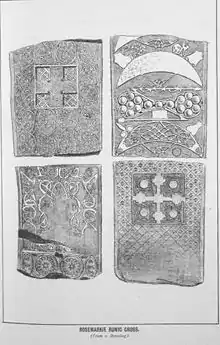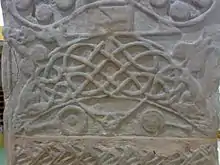Rosemarkie Stone
The Rosemarkie Stone or Rosemarkie Cross, a Class II Pictish stone, is one of the major surviving examples of Pictish art in stone.


Carved from fine-grained sandstone, the Rosemarkie stone was found sometime prior to 1821 in the floor of the old church in the village of Rosemarkie. Rosemarkie was the probable site of a major Pictish monastery, on the Black Isle of Easter Ross. When found, the stone was broken into two parts that have since been reconstructed.[1] The reconstructed stone is now on display in Rosemarkie's Groam House Museum.[2]
On the front side is an elaborately decorated cross, while on the reverse side are various common Pictish symbols, including three crescents and v-rods and a double-disc and Z-rod, as well as a smaller cross at the bottom. It is the only Pictish stone to bear three versions of the same symbol. The sides are also decorated with a number of interlace patterns.
See also
References
- "Rosemarkie, Church Place, Rosemarkie Parish Church, Cross Slab | Canmore". canmore.org.uk. Retrieved 2016-05-11.
- "Groam House Museum | OUR SCULPTURES". www.groamhouse.org.uk. Retrieved 2016-05-11.
Further reading
- Fraser, Iain, Ritchie, J.N.G., et al., Pictish Symbol Stones: An Illustrated Gazetteer, (Royal Commission on the Ancient and Historical Monuments of Scotland, 1999)
- Jones, Duncan, A Wee Guide to The Picts, (Musselburgh, 2003)
- MacNamara, Ellen, The Pictish Stones of Easter Ross, (Tain, 2003)